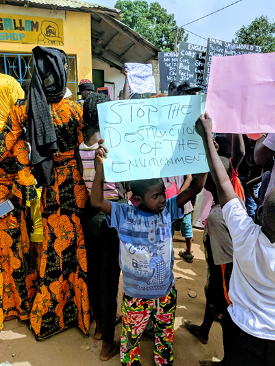
Protest in Sanyang, 2018
In June, 2018, I protested alongside locals to plead with the Gambian government to mitigate the ongoing conflict between a fishmeal factory and Sanyang village residents. The Nassim factory processes sardinella into feed stock, a flour-type material, for the Chinese aquaculture (fish farming) industry. The protest demonstrates how the global aquaculture food chain negatively impacts local and poor communities, while simultaneously feeding global and more wealthy communities cheaply. According to the National Oceanic and Atmospheric Administration, the United States is the leading importer of seafood products worldwide. Its imports make up about 90 percent of seafood consumption, of which about half is farm-raised, mostly from China and Vietnam. Young men and women led the protest in Sanyang, along with women gardeners who claim that their plants have been impacted by pests from the factory. The protest led to a short-term closure of the factory in late 2018 by the Gambian National Environmental Agency (NEA). Yet the fishmeal factory resumed operations soon after, when the ban was lifted. Sanyang is not the only coastal village battling Chinese-owned/affiliated fishmeal factories in The Gambia. In Gunjur, there is the Chinese-owned Golden Lead, and the Mauritanian-Chinese JXYG is in Kartong Village. Residents of all three coastal communities claim livelihood and environmental destruction caused by operations of the factories. Gunjur and Sanyang residents especially continue to protest against the factories.
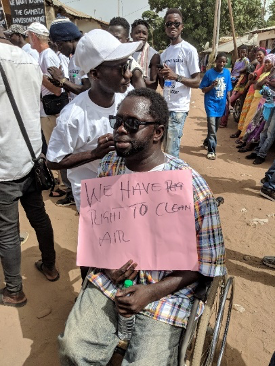
Protest in Sanyang, 2018
The Aquaculture Industry and Fishmeal Production
According to the United Nations Food and Agriculture Organization (FAO), the total value of fisheries and aquaculture production in 2016 was estimated at $362 billion—with the latter sector counting for $232 billion. China is by far the major producer in the global aquaculture industry. The United States and Japan are the largest importers of farmed fish, depending on imports for some 60 and 54 percent of their consumption, respectively.
The FAO predicts that about 16 percent of capture fisheries’ yield will be used to produce fishmeal in 2030. Fishmeal is crucial to aquaculture; it is one of the most notorious feeds for farm-raised fish. Many different species are used for fishmeal production, but small pelagic fish such as mackerel, herring, sardines and anchovies are predominant. Small pelagic species are used for both human consumption, especially in West African markets, and the production of fishmeal.
Fishmeal Factories and Coastal Communities in The Gambia
Chinese investors fully or partially control all three fishmeal factories in The Gambia. The operating license of the first factory, Golden Lead in Gunjur, was issued under the government of authoritarian President Yahya Jammeh in 2016. In 2017, local residents were worried about the potential environmental impact of the factory, but they welcomed it due to the promise of economic benefits such as increased employment, infrastructure and training proposed by the factory. Residents of Kartong and Sanyang also were excited about similar opportunities promised by their factories when they established operations after President Jammeh lost the 2016 election. However, tensions between the factories and local residents in all three villages arose after a few months of operations, as residents started to complain about a series of environmental degradation issues, such as pollution, waste dumping into the sea and a noxious fishy smell. They also contended that their income streams had been disrupted, causing food insecurity.
Environmental Degradation
Golden Lead installed a pipe that disposes of untreated wastewater from the factory directly into the sea. Ahmed Manjang, a biomedical scientist, tested the local water in Gunjur and found it to be unusually high in phosphates. This finding resonates with local residents’ claim that since the factory arrived in Gunjur, a lot of dead fish and aquatic mammals have washed up on the beach due to toxics from the factory.
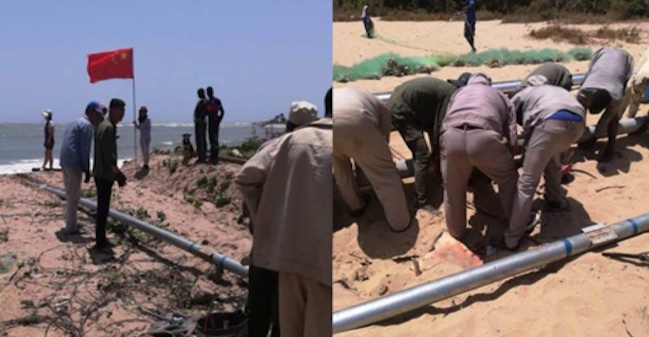
Installation of waste pipe in Gunjur. Source: GAINAKO
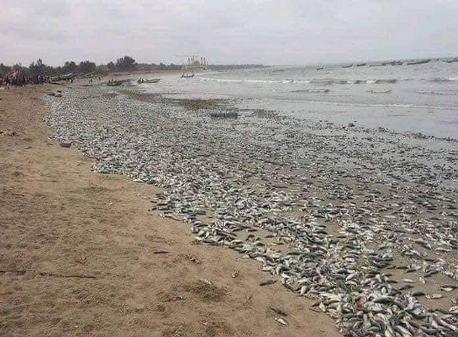
Dead fish on beachfront in Gunjur
Furthermore, in 2017, the water in the Bolong Fenyo, a community wildlife reserve owned by the community of Gunjur, suddenly changed color, to red.
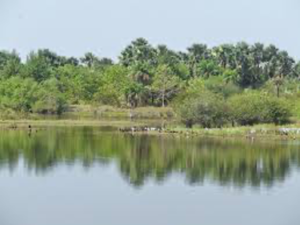
Bolong Fenyo, before and after. Photo: Green World Warriors

Similarly, Nassim in Sanyang installed a pipe dumping its industrial effluent just 50 meters out to sea, in full view of beachgoers and local residents. In protest, residents dug up the waste pipe in 2018. However, the pipe was reinstalled within days, as police arrested four local youths. The pipe continues to dispel toxic waste.
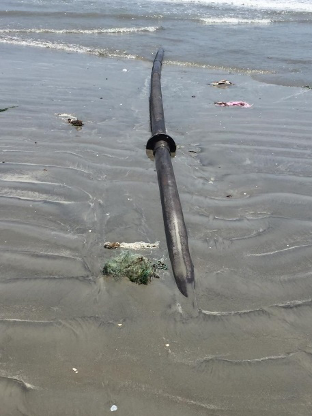
Waste pipe from the factory in Sanyang
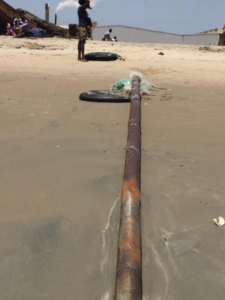
Livelihood Disruptions
The price for sardinella, a cheap and abundant source of proteins for locals, increased as its supply was disrupted by the factories. Fisherfolk prioritize the factories over local markets. In addition to food insecurity claims, local communities posit that the factory is disrupting the income of locals. The tourism industry is one of the biggest sources of income for local communities, especially for the youth in Sanyang. Residents claim that the factories are driving tourists away due to the pungent smells and pollution. Moreover, women vegetable gardeners in Sanyang, who rely on garden yields for income generation and work close to the factory, complain that they witnessed two consecutive years of bad yields due to garden contamination caused by flies that carry bacteria from the factory.
Government’s Response and Implications
Despite changes in power, from an authoritarian to a more democratic and neoliberal regime, the government of The Gambia has been vacillating in the face of the conflict between local residents and the factories. Ultimately, the government always takes the side of the factories without explanation. The three factories were temporarily closed several times due to complaints and protests, but they all reopened with no clarification to residents from the government. In Gunjur, the NEA filed a lawsuit against Golden Lead in a four-count charge related to the factory’s pollution, and ordered a temporary shutdown of the factory in 2017. However, an announcement from the Office of the President followed: it declared that the NEA case against Golden Lead had been withdrawn and that the matter had been settled out of court. Locals claim that the president’s intervention was due to the government’s yearning for foreign investments and neoliberal goals. The factory eventually reopened, after the NEA pledged that the waste piped into the sea would be safe and treated. Gunjur activists, however, had the wastewater of the factories tested in Germany, and found that it is loaded with proteinaceous material and highly carcinogenic metalloids. Local residents have filed court cases seeking reparations for environmental degradation.
In Kartong, the factory was banned in 2018 after protests by residents against its discharge of toxic waste into the sea. However, as in Gunjur, the ban was short-lived. As noted earlier, Kartong residents have been less vocal than residents in Gunjur and Sanyang.
In Sanyang, the factory was temporarily banned by the NEA in 2018, but the ban was lifted shortly thereafter. In January, 2019, protests ensued in Sanyang over the NEA’s failure to show up for a scheduled meeting with community members. The meeting was supposed to set terms to mitigate the conflict between local residents and the factory in Sanyang.
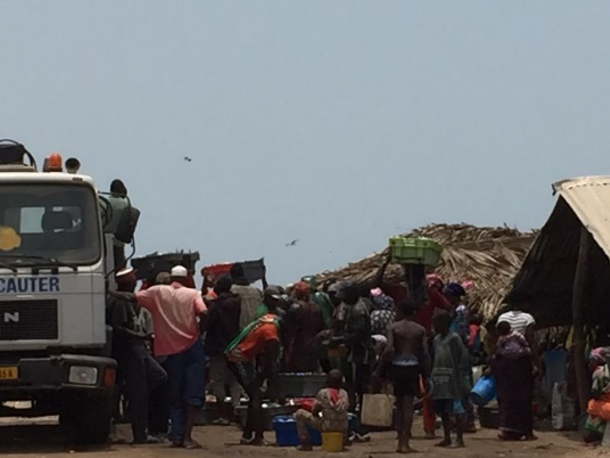
Fisherfolk unloading during COVID-19 crisis
Remarkably, the factory in Sanyang continues operations during COVID-19, despite a state-of-emergency declaration, a government-mandated lockdown of nonessential businesses, and border closures. Fisherfolk still come from Senegal and Guinea-Bissau to supply the factory, violating the government-mandated 10-person limit on gatherings. I am currently awaiting confirmation as to whether the other two factories are operating. Nevertheless, until the government takes a more critical stance in mitigating the conflicts between the factories and locals, the struggles will continue.
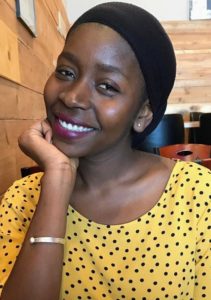
Fatou Jobe is a master’s student in African Studies at UIUC. Her research aims to highlight the environmental, economic, and political impact of global aquaculture on local communities. She plans to pursue a PhD to further her study of fishmeal factories in West Africa.
The Public i especially appreciates contributions by international students, faculty and others, sharing their experiences and knowledge; email us at publiciatimc@gmail.com.
1,393 total views, 1 views today
